Look at this front-page advertisement in one of the leading print media.
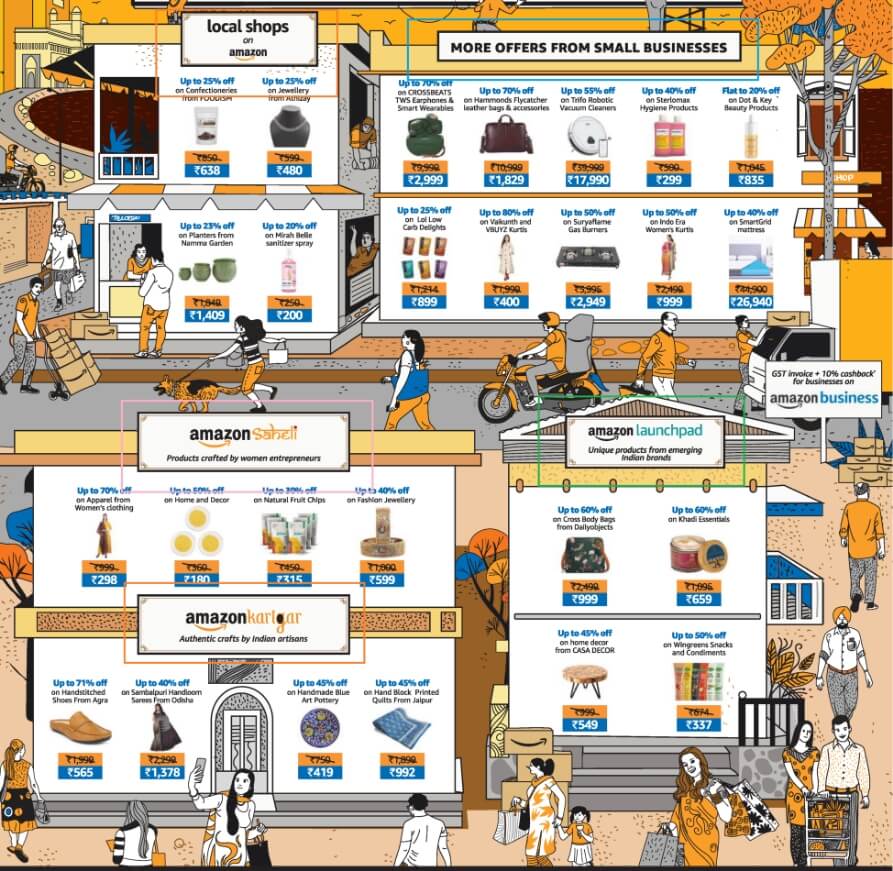
Image-1: How Businesses are Getting Diversified Online
Leaving aside the promotional content, the nature of this print advertisement showcases the buzzing categorization of the online marketplace – women entrepreneurs, artisans, local shops, emerging digital companies, cloud kitchens and more creating a “brand” out of themselves – all for the sake of visibility and outreach.
While some are enjoying a formidable offline presence, many are proactively investing in omnichannel marketing. At this point, most brands are not just selling solely on their website; they are selling on various e-commerce platforms, as well as social media, and in brick-and-mortar shops.
According to a survey by Square and Mercury Analytics on US business owners, common channels where brands sell their products and services include:
- Brick-and-mortar shop (56%)
- Website (34%)
- Pop-up shops, events, and markets (26%)
- Facebook (25%, but 40% as a whole on social media, including platforms such as Twitter and Instagram)
- Amazon (16%)
- Others (22%; includes eBay, Alibaba, Etsy)
“Digital technologies are empowering brands to reclaim the customer relationship, shifting the balance of power away from retailers.”
A report from Deloitte noticed a trend where the consolidation of major retail industry players has strengthened the hold on their customer base. Brands, on the other hand, are left with little negotiating power to go directly to customers offline.
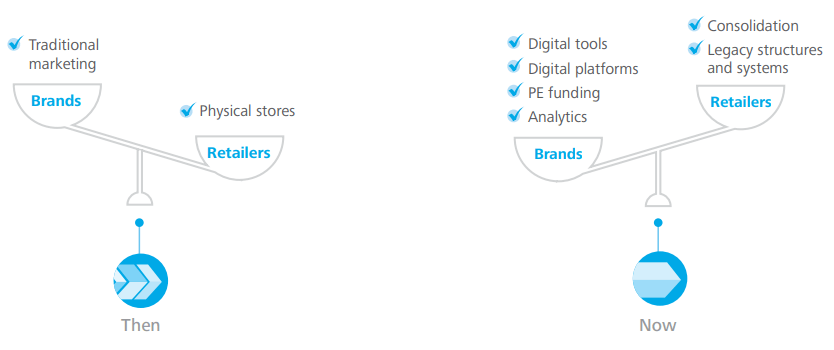
Image-2: New Opportunities for Brands. Source
Brands now opt to take advantage of digital platforms and tools to reach out to their customers. Moreover, because private equity (PE) funding is now more accessible, brands can more easily expand and go directly to customers while retaining complete control of the channel.
Going direct allows brands to gain access to their customers which was previously difficult to do as customers primarily interacted with retailers.
Brands can use the data they collect online to refine their products and offerings and better meet customers’ needs and demands. They can expand their reach across the country or around the world and sell goods more profitably.
And they can do it without making significant investments in infrastructure or establishing vendor agreements with local retailers.
So, how to best market such brands?
In mature digital markets like the USA, the UK, Canada, instead of relying on mass advertising, marketers can now focus on building continuous relationships with buyers through unique digital means.
“Not that what we are suggesting here is something out of the box but this digital strategy is yet to be championed by many brands, i.e. Branding via SEO– dominating the SERP via Local SEO.”
What is Local SEO?
Local SEO is the practice of optimizing a website in order to increase traffic, leads, and brand awareness from local search.

Image-3: Sample Google Local Serp
A local SERP would typically include a local pack, local finder, localized organic results, Google Knowledge Panel, Google Posts, Google Shop, Featured Snippets. Brands should aim to appear here.
Tasks associated with local SEO include finding local keywords, optimizing a business’s Google My Business profile, and building “NAP” citations.
But before realizing the full potential of local SEO, let us discuss a few related terminologies, and how is local SEO beyond lead generation & ORM.
Also Read
What Is Online Brand Communication?
“Branding is a marketing practice used to identify and differentiate companies, products, services, and people from their competition.”
Start with entering your business name on Google Trends.
Do you see any search data centered around your product/service?
If no, start communicating online!
One of the biggest differences experienced by brands already operating in a bricks-and-mortar context when they launch online is how they communicate their brand.
In a traditional retailing context, a brand is communicated in a controlled fashion. The onus is on the retailers to do their best through advertising and marketing to send a message on behalf of brand purpose and build a positive impression.
In an online context, it is all about allowing customers to communicate amongst themselves about the brand and in many cases actively endorse the brand to a wider online audience – through online reviews, ratings.
The primary method of brand communication online is the business’s website. Other options available to them beyond websites, include Facebook, Twitter, YouTube, Instagram, Pinterest, each of which has a different focus and outcome.
Eventually, the focus should be on:
- Brand Positioning Online, and
- Effective Employment of Online Tools – SEO, PPC, Social Media.
#1 Brand Positioning – Personal Branding VS Product Branding
Today, in permission and the privacy-driven world, marketing is becoming even more suspicious to consumers. Therefore, it is even more important for brands to bring out real, authentic connections and engagement with their target customers and give lesser importance to marketing and selling campaigns.
“Marketing is about making a promise, but Branding delivers on experience.”
When most organizations mention branding, they’re referring to the carefully crafted perceptions surrounding their products or services designed to create an emotional response in their target audience – product branding.
But there’s another type of branding that can be equally important in marketing your business – one that is revolving around a personality – personal branding.
Neil Patel advises in one of his earlier blogs,
“If you want to build a lifestyle business then consider building a personal brand. It’s easier to build, and you can make good money from speaking, consulting, or partnerships.
But if you want to build something big, something that will continually live and move on without you, then focus on building a corporate/product brand.”
However, there is no real difference when you are building a personal brand or product brand as the entire strategy is to focus on a certain group of people. If you think about it, business brands have already started to behave more like human entities – adopt a personality or authenticity or a tone of voice to establish beliefs/values.
#2 Effective Deployment Of Online Tools – ORM & Local SEO
To build pipelines in sales, search engines allow marketers to generate leads through several methods, including search keyword analysis or paid advertising that is referred to as pay per click or PPC.
Subsequently, lead generation techniques prompt users to interact – like filling out forms or comment on engaging posts – with the information present online about the brand.
However, the online marketing campaigns have become so obsessed with employing SEO for certain targeted keywords that they fail to recognize its impact on the end-users. Here is where Online Reputation Management (ORM) kicks in.
Through ORM, brands focus on multiple online sites – business websites, online directories, social media profiles – to shape public perception and create a spotless image about themselves through influencing online information. Some of the best practices following ORM would be social media monitoring & response, public relation campaigns, building positive content, etc.
Traditional SEO is ably supported and strengthened by ORM during web analytics, web development, content development.
But what happens when information about the brand is optimized for local “near me” search online?
People do a local search with a strong intent to buy –
60% of smartphone users have contacted a business directly using the search results such as the “click to call” option.
Thereby, local SEO automatically bypasses the need to deploy outbound lead generation techniques and cut-short the role of ORM to maintain positive public relations, thereby saving additional efforts.
More importantly, local SEO is free and behaves just like organic SEO but limited to geography!
TABLE OF CONTENT
2-STEP SETUP FOR LOCAL SEO
Stage-0
- Optimize Website/Search Results for Mobile Device
- Create Business Profiles on popular Search Media & Social Media
Stage-1
- Keyword Research For Local Organic Ranking
- On-Page Optimization
- Schema Markup
Stage-2
- Local Citations
- Build Backlinks
DON’T MISS BRANDING VIA SEO COMPONENTS
DON’T MISS BRANDING VIA SEO COMPONENTS
Techniques
- Glocal SEO VS Local SEO For Brands
- Personal Branding With SEO VS Product Branding With SEO
Case Studies
- Example: Local SEO Case Studies Of Cafe & Restaurant Brands
- Example: Local SEO Case Studies Of Top Chefs
Local SEO Across Industries
- How Local SEO Can Help Digital Products/Brands?
- How SEO, SEM, And Content Marketing Can Help SaaS Products/Brands?
- Local SEO For Brands With Multiple Location Businesses
- Local SEO For Non-Profit Brand Communications
KEY TAKEAWAYS
2-Step Setup For Local SEO
Before we begin the setup for local SEO,
- Check your Moz local listing score to see how accurate your business listings appear on the web.
- It is equally important to understand how local SEO works.
At a macro-level local SEO works like a “normal” search – search engines scan through its index to provide the best results for that person’s query.
Whereas, what makes Local SEO unique is that Google* uses a different set of ranking factors to rank the local search results, including:
LOCAL PACK
- Google My Business (33%)
- Reviews (16%)
- On-page (15%)
- Links (15%)
- Behavioral (8%)
- Citations (7%)
- Personalization (6%)
LOCAL ORGANIC
- On-page (32%)
- Links (31%)
- Behavioral (10%)
- Personalization (7%)
- Google My Business (7%)
- Citations (6%)
- Reviews (6%)
- Google My Business Signals – keywords in the business title and description, proximity, and the right categories.
- On-Page Signals – name, address, and phone (NAP) of your local business, keywords in titles, and domain authority.
- Link Signals – inbound anchor text, linking domain authority, linking domain quantity, etc.
- Behavioral Signals – click-through rate, dwell time, pogo-sticking
- Citation Signals – from generic, niche, and hyper-local sources
- Review signals – including review recency, quantity, velocity, and diversity. The stronger your review portfolio, the bigger the impact on local search performance.
- Social signals – engagement on Facebook, Twitter, LinkedIn, YouTube, etc.
*(Bing, Yahoo, or other search engines may be doing it differently but their market share is not large as compared to Google.)
Based on these factors, we have devised a 2-step setup for local SEO.
You may also want to check out our local SEO services checklist.
Also Read
STAGE-0: GO MOBILE FIRST
With Google holding a market share of 95.23% worldwide in mobile search, it would only take a blunder to not optimize your business website for mobile searches
“Google prioritizes mobile when crawling and indexing websites for local search terms …”
What this means is that web crawlers will read & index your mobile site first. Eventually, it may hurt your position in the local search results if your site isn’t mobile-friendly.
One of the best ways to begin with testing the mobile-friendliness is to use Google’s mobile page testing tool.
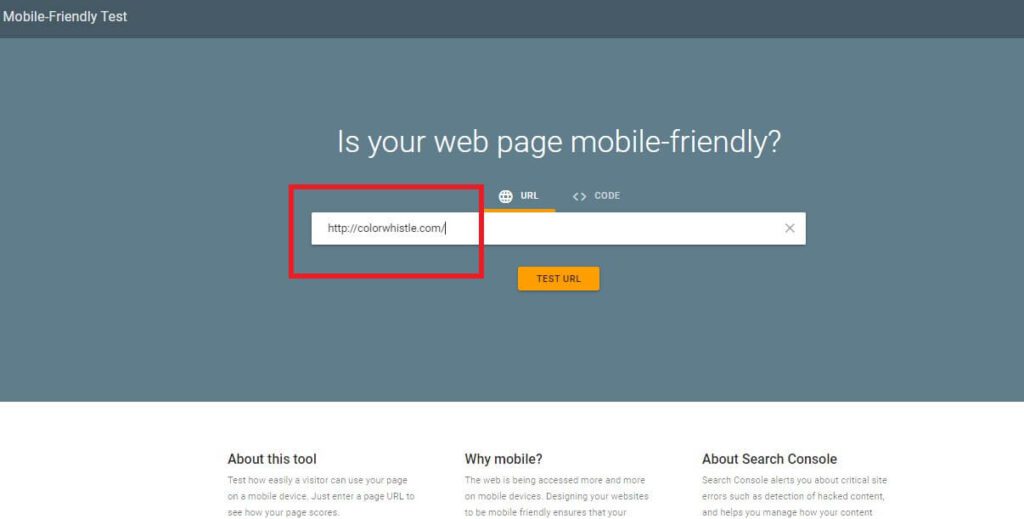
Image-4: Homepage Screenshot of Google Mobile Testing Tool
Simply enter the URL of the desired page and click “Test URL”.

Image-5: Results Screenshot of Google Mobile Testing Tool
That’s how the test results are displayed. Page loading issues, if any, will be highlighted separately.
STAGE-0: CREATE BUSINESS PROFILES
This is arguably the most important part of local SEO.
“Claim & optimize your Google My Listing (GMB), Bing Places, Apple Maps, Yelp for local SEO. Create business profiles on Facebook, Instagram, Youtube, LinkedIn only if you are serious about your Online Brand Communication!”
Setting up your GMB listing is easy. You can read our previous blog to follow a detailed setup guide.
However, there are certain things you must keep in mind while creating business profiles for local SEO:
- Keep your NAP- Name, Address, Phone Number consistent across all your profiles online. Only Google My Business signals (which includes NAP within the business profile), review signals, and link signals are more important for local pack rankings.
- Your business name is not meant for “keyword stuffing”. Say, you are claiming your GMB listing for a coffee shop you own. Use your ‘brand name’ for business and not like Coffee Shop Downtown NY 24/7 – ‘brand name’.
Additionally, when it comes to NAP, ensure a few other things:
- Always use your real-world business name.
- Always use your real-world address.
- Use a local phone number whenever possible and not a call center helpline.
While managing user reviews, uploading the latest photos/videos/news of your brand, setting up business working hours, etc. falls under the domain of Online Reputation Management, some of these functions can be optimized for local SEO, for example, uploading images!
Here are 8 essential tips to optimize your image for local SEO.
STAGE-1: KEYWORD RESEARCH
- Local Map Pack
If you are a brand targeting a particular area or a business owning a franchise, you should look to rank higher on the Local Map Pack.
But the issue with local SEO is that the results may be different from one mile to the next.
For example, someone searching for “coffee shops” from 72nd street, 2nd avenue, and from 24th street, 5th avenue in NYC would find two different sets of SERPs. It is super tailored to the current location of the searcher.
Tip: As a Marketer, you should not track your local rankings from a single location alone. Instead, you can micro-analyze your local rankings in different locations with the city. This way, you can see where you rank across your entire city or local area.
One way of doing it is through Map tracking tools like Local Falcon or Local Viking. However, both would extrapolate your business information from the GMB listing.
Here is a screenshot from Local Falcon analyzing a certain hotel business in Boston,
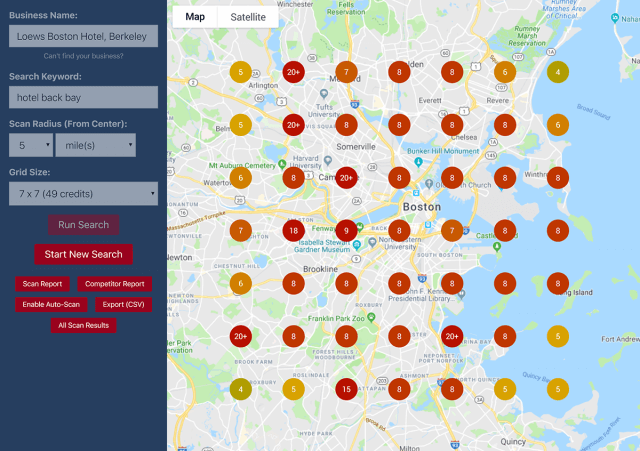
Image-6: Results Screenshot of Local Falcon Ranking Tool
The image first appeared in backlinko’s guide on local SEO.
The grid-like structure on the Map represents the “local ranking” of the said hotel across various locations in Boston.
Tip: Knowing your rankings across various locations, you may narrow down to focus on a particular area within the city. A good number of user reviews, ratings, targeted PPC ads, social media relevance may contribute to a higher ranking in the local map pack.
- Local Organic Search
Most local searches have an extremely strong commercial intent and ranking higher in the local organic search is equally desirable.
Unlike the Local Map Pack, the local organic search remains the same for any Google SERP.
Tip: Actually, the only unique thing about local organic rankings is how you track them. While optimizing a business for “” keywords, in many cases, the generic “” keyword without a location may get more search volume, and so says Google.
So in addition to “Essex Gardeners”, you may also track your local rankings for keywords like “Gardeners” and “Gardeners near me”.
In conclusion, local keyword research revolves around identifying three parts of your target search queries –
CORE TERM + KEYWORD MODIFIER + LOCATION
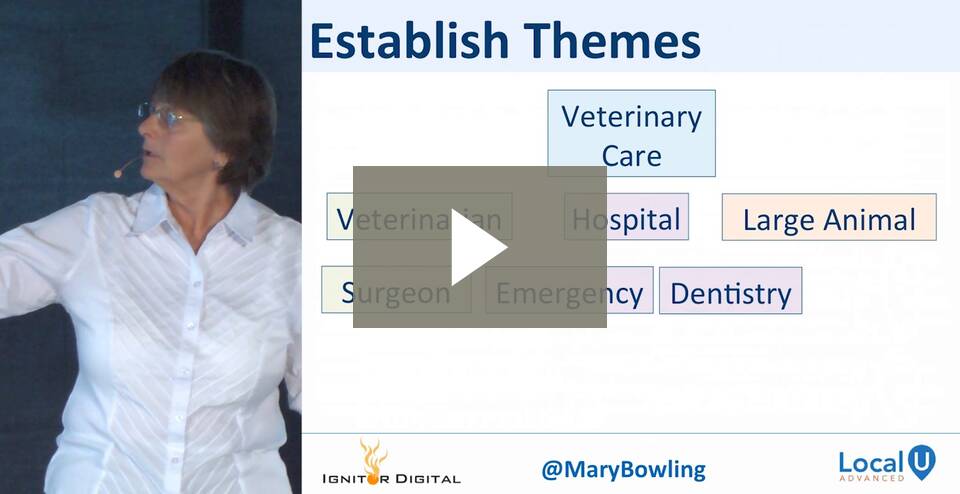
Moz – Getting Local Keyword Research and On-page Optimization Right
Use of semantic analysis tools like Text Optimizer can be used to identify core terms. To identify your keyword modifiers, use popular SEO suites like Ahrefs, Google Search Console, SEMrush, Moz Pro, UberSuggest, etc.
For location terms, you may rely on your own business knowledge, Google search, and your on-site analytics. Diversify your localization options by adding stats, cities, counties, etc. to your keywords.
STAGE-1: ON-PAGE OPTIMIZATION
Use the following techniques that overlap with traditional SEO:
- Keyword in H1 Tag
- Keyword in Title Tag
- Keyword in URL
- Use short URL
Further, Optimize Home Page for local SEO as follows:
Most single-location businesses should optimize their home page for primary location. (we had already discussed the reason in the previous section. For the same keyword “coffee shop near me”, your business may rank high in your primary location while it may not be five blocks away!)
So,
- Show NAP (Name, Address, Phone Number) information on the homepage. In fact, add it to the footer of your entire website.
- Add Testimonial & Reviews and use Schema Markup.
STAGE-1: SCHEMA MARKUP
Schema Markup is a code that you can add to your website to improve the way search engines read and represent your page in the SERPs.
In most cases, coding might be messy and so make use of tools like:
- Google’s Structured Data Markup Helper
- Structured Data Testing Tool
- Bing Guide to Marking Up Your Site
Step1: Select Data Type
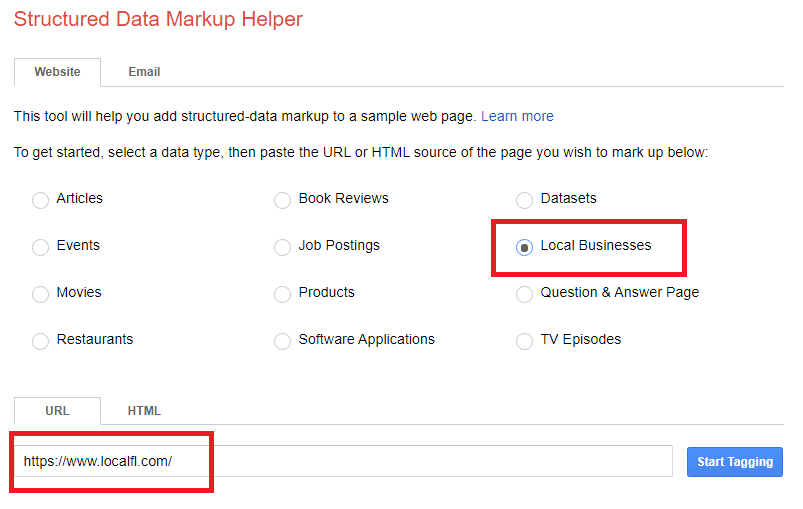
Image-7: Schema Markup using Google Tool
Step2: Click On Elements You Want To Tag

Image-8: Schema Markup using Google Tool
The tool will take in the marked-up elements and generate an HTML code that you can add to your website.
You may find some additional information on Schema Markup for Local SEO on Google/Bing in one of our previous blogs. Go check it out!
STAGE-2: LOCAL CITATIONS
Citations are nothing but online mentions about your business, typically other than your own business website. The approach to building citations can be divided into two ways:
- Building structured citations – like business directories or social profile (Yelp, Facebook, Google Maps, Apple Maps, MapQuest, Foursquare)
- Building unstructured citations – like blog posts, vendor pages, other review websites
Essentially, through citations, Google has been asked to trust the information that it already has about your business and push your business to the top of the SERP for your target keyword.
Hence, focus on:
- Citations Audit – ensuring that existing citations are correct and consistent
- Building more relevant citations
For starters, here are some great resources- Whitespark and Loganix to find out the top citation sources for your country of operation. You may further branch out to geographically-relevant citations and niche-specific citations, say:
TripAdvisor (for restaurants, hotels, etc.)
FindLaw.com (for attorneys)
HealthGrades.com (for doctors)
HomeAdvisor.com (for plumbers, tradespeople, etc.)
Comparing your strategy with your highest competitor is another way to build citations. (You may use Ahrefs Site Explorer to check out who your competitors online are!)
Find out Anchor Texts that your competitors have used. The below screenshots explain what an Anchor text is:

Image-9: What is Anchor Text? Source
You may need to look for anchor terms like:
- “Visit website”
- “Website”
- “Visit site”
- “Click here”
- “View website”
- [Naked URLs]
Generic anchors like these often come from directories. Using Ahrefs Site Explorer may ease the task.
STAGE-2: BUILD BACKLINKS
Follow these two points:
- Create local resources relating to your niche – blog posts, short video content can do well.
- Engage in Guest blogs for local websites to signal authority.
Here is a great blog post by Brian Dean on link building strategies.
PRO-TIPS & STRATEGIES
GOOGLE POST:
Boost your local SEO presence with Google Posts.
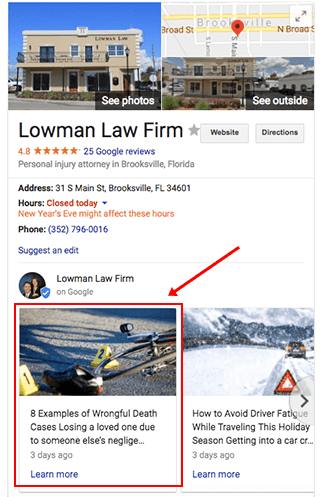
Image-10: Example of a Google Post
When Google first rolled out this feature in mid-2017, it said 82% of people turn to search engines to find local information and learn more about businesses in their area.
Google Posts allow you to publish a story, article, poll, event and is a great way to keep your customers informed and engaged with your business. Further, it is a great start towards making your own brand identity.
To set-up this feature,
- Go to http://posts.google.com/author.
- Click the Publish on Google text box.
- Choose your post type, and follow the onscreen instructions.
LOOK OUT FOR INACCURATE EDITS ON YOUR GMB LISTING:
If you are not still unaware, anyone can suggest an edit to your GMB listing & Google may sometimes accept it. You cannot do anything about it but you can ensure that your listing is correct and up-to-date at all times.
FOCUS ON UX FOR LOCAL SEO
- Location-focussed keyword in the H1 tag.
- Optimize your homepage title tag around 2-3 keywords.
- Use Google Ads to find compelling description copy for meta description.
But why?
When a local searcher lands on your page, they need to know that you serve their area within 2 seconds.
Don’t Miss Branding via SEO Components
Google identifies different micro-moments in one’s daily digital life:
- Want-to-go moments: information on local restaurants, cafes, etc.
- Want-to-do moments: information on local events, activities, etc.
- Want-to-buy moments: information on local shops, etc.
- Want-to-know moments: general information which brands may monetize
Google also shares a great story to show how such moments trigger actions and lead to sales.
“Neel needed to find a laptop cover immediately.
Caught in the rain at uni, Neel worried about the safety of his new laptop, which got wet in his bag. Acting at the moment, he turned to his smartphone to find the best laptop covers. Within a few minutes, he discovered a new brand he loved and decided where he was going to buy it. An hour later, he went in-store and made the purchase.”
You or your product, too, can become the brand that interprets such moments of need and shows up in search results when your prospects look for you.
Listen to the insightful advice on getting your brand name “autocomplete” in Google.
Building your brand image online focuses on the different user experience modules.
Refer to the below user experience honeycomb graphics.
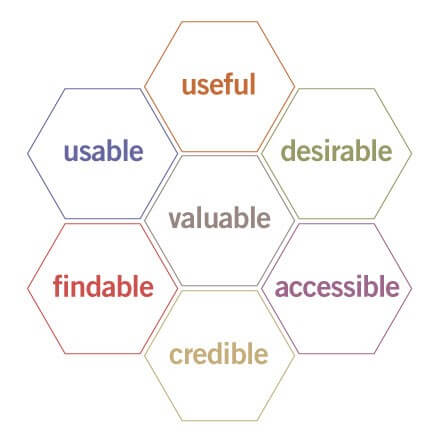
Image-11: User Experience Honeycomb by Peter Morville. Source
- Useful: Your content should be of high quality, useful, and relevant.
- Usable: Your site should be easy to navigate.
- Desirable: Your design should appeal to your target audience.
- Findable: You should focus on content and make searching for information easy.
- Accessible: Your site should be mindful of people with disabilities.
- Credible: Your brand must show signs of authority and prompt trust.
Coincidentally, most of these attributes map directly to SEO.
So, how do you cater to both the search engines as well as your prospects?
Personal Branding With SEO VS Product Branding With SEO
Building a personal brand or product brand is strategized to focus on a certain group of people as they discover you online through SEO.
There are two goals in Branding with SEO:
- Dominate the entire first page of Google (branding)
- Push negative or embarrassing search results off of page one (reputation management)
Ironically, when we searched online for competing blogs on the same topic, the first result on SERP was this checklist for Personal SEO by Neil Patel.
Why the irony because Neil Patel has created a brand out of his personality and now runs a successful digital agency named after him, NP Digital!
Check this out to know why choosing the right brand name is the best SEO hack!.
Glocal SEO VS Local SEO For Brands
Glocal marketing is a tested strategy employed by global brands to adapt to local needs. It aims at maintaining global brand messaging while catering to the needs of the local culture by combining “Global” and “Local” marketing strategies.
A classic example could be of a global brand like McDonald’s whose brand message is to offer simple and affordable fast food but their menu varies depending on the local population.
Glocal Marketing is based on three pillars:
One strategy that is outrightly discussed in this guide is local SEO and the same fits here as well.
Global brands may require more marketing efforts – especially content marketing – than local brands to establish their brand identity among the local population. Local brands may by virtue hold a good reputation and only require to target specific local search keywords to rank better on SERP.
Here is a wonderful blog post on how to localize your global brand customized for different countries. Do check it out!
LOCAL SEO ACROSS INDUSTRIES
How Local SEO Can Help Digital Products/Brands?
Knowledge Commerce is a booming industry and also responsible for the growth of digital products.
A digital product can be:
- Online Courses
- Stock Images that can be sold to stock photo websites
- Music – you will be amazed to learn about the story of Musician, Singer Amanda Palmer. She has relied on grassroots marketing to sell her band’s music and never relied on any major label
- WordPress themes
And much more.
Branding around these products is easier since most of these products can be traced back to its creator. We had already discussed Personal SEO through branding and reputation management – blog posts, webinars, landing pages, and other marketing assets.
One other prominent example of a digital product is a SaaS company.
SEO, SEM, And Content Marketing For SaaS Products/Brands
These days seem like every other business is offering some kind of a product based on a Software-as-a-Service (SaaS) model.
And if you are a Small-Medium-Business (SMB), you are likely to be intimidated by the number of successful case studies of certain SaaS products gaining millions of customers online in quick time.
However, quoting Sujan Patel from one of his videos,
“SaaS growth is all about building the flywheel of customer acquisition that moves faster and faster until its momentum pushes itself and you can reach escape velocity.”
In this section, we will be carving a SaaS brand out of this ‘flywheel’ using some amazing SEO, SEM & Content Marketing strategies.
General SEO best practices – crawlable, indexable, and authoritative – don’t really change, regardless of the vertical or niche. And so here are some unique areas to focus on while branding SaaS via SEO:
- Keyword research should focus on long-tail keywords rather than competing with higher search volume keywords in which larger competitors already hold a significant market share
- Shifting the focus to specialized content creation to compete with indirect competitors like review aggregators (say, Capterra)
- Brand visibility online for SaaS products is determined by Key Performance Indicators (KPIs) like Marketing Qualified Leads, Monthly Recurring Revenue, Customer Acquisition Cost. Less attention needs to be given to search traffic

Image-12: Three Pillars of Branding SAAS via SEO. Source
Watch the below Q&A session for some valuable answers on:
- Should all SaaS companies invest in SEM?
- How does SEM differ for an SMB SaaS company versus an Enterprise SaaS company?
- LTV metric takes a long time and so should I just optimize my SEM spend to a cost per acquisition?
- If I have a limited budget, should I bother with competitor terms, or even non-brand terms?
Watch another interview with a B2B SaaS Marketer to know his insights on:
- How do you pull people through the funnel with content marketing?
- Why design “Topic Clusters” to build your own SaaS brand?
- Is there a suggested process for building content upgrades?
- How are natural language processing algorithms affecting content creation?
- How to approach a client that doesn’t have a clear bottom-funnel search volume?
- How do you approach link building in the SaaS market?
- How should people approach ranking for “vs” or “alternative” keywords in SaaS?
Here is another interesting resource on SaaS vs Conventional Digital Marketing. Do check it out!
Local SEO For Brands With Multiple Location Businesses
Businesses with multiple-locations are exempt from the rule of optimizing their home page for primary location.
They must now focus on local landing pages.
So, Include location’s NAP, operating hours, and focus on related keywords targeted at that location on the respective landing page.
The screenshot below analyses the website traffic (2018) of a car rental business in the USA. In addition to a home page, the website has unique local landing pages for every service location.
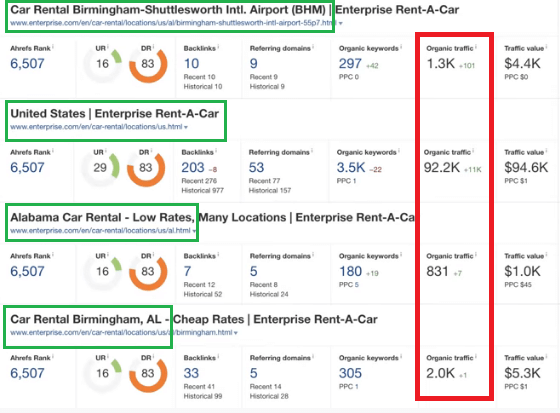
Image-13: Why Multiple Location Businesses Should Focus on Local Landing Pages
It is satisfying to note that the organic traffic that these local landing pages attract are equally profitable.
Local SEO For Non-Profit Brand Communications
As more people turn to digital to find, research, and evaluate charities that align with the causes they care about, your online reputation becomes increasingly important.
“Nonprofit marketers can leverage the online search with local intent to engage supporters, drive donations, and share their nonprofit’s mission with the world.”
If you have more than a few locations, we highly recommend creating and managing a single source, like a spreadsheet, that has all your business’s location data centralized and organized in one place.
Later, claim your GMB for all your locations. Here are step-by-step instructions from Google. Additionally, complete your GMB listing by:
- Include a primary business category and add up to 9 additional categories for better outreach
- Select attributes for your business if your nonprofit identifies as Black-owned or women-led, LGTBQ+ friendly, etc.
- Include ‘local’ keywords in the business description: Match it with the location of our non-profit business
- Adding more photos will attract more views and hence improve ranking. It is observed that businesses with photos receive 42% more requests for directions and 35% more click-through to websites. While uploading photos, make sure to name them using a local keyword
Claiming your GMB alone will not suffice. You should now develop an online review strategy for online public relations.
Listen about SEO strategy from a Senior Community Engagement Manager at Mightycause.com
Example: Local SEO Case Studies Of Cafe & Restaurant Brands
The following case study was first published here.
Here is a gourmet cafe named Cucina & Co. in the classic marketplace – Rockefeller Center, New York. They hired an agency to increase the number of people who found them online for search keywords like breakfast and lunch options near Rockefeller Center.

Image-14: Google Analytics Showing the Search Traffic – Blue Area After the Implementation of Local SEO
The agency chose to optimize the cafe’s online presence – business website, third party directory listings (i.e. Google My Business, Bing, Yelp, Foursquare, Apple Maps, etc) – through local SEO. The graph above summarizes their effort in significantly increasing the traffic count organically.
Example: Local SEO Case Studies Of Top Chefs
The following case of creating a brand out of a living chef was first published here.
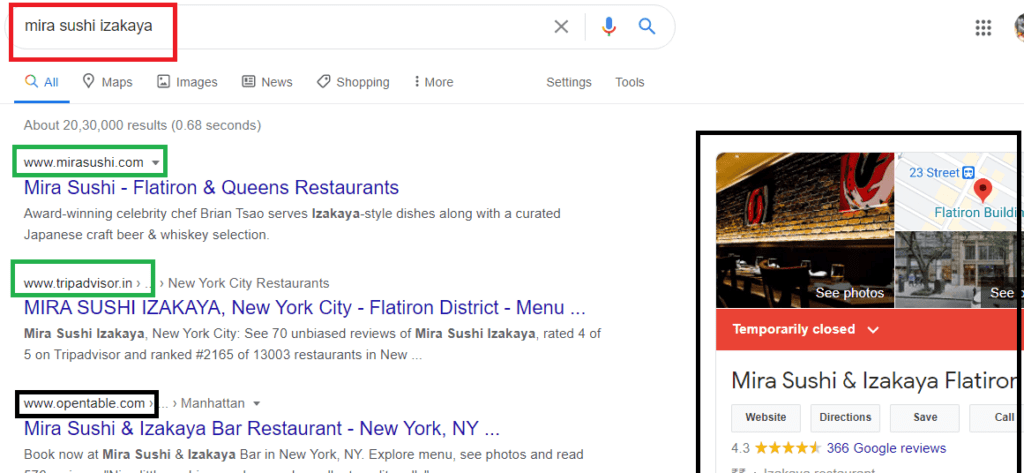
Image-15: Google SERP for Brand Search
For brand marketers, that’s a victory right there; the brand’s website is appearing on top of third-party review aggregators!
An agency was tasked with building a brand around a particular restaurant in New York. The agency’s strategy was centered around creating a unique identity separating it from the market via relevant social media platforms, web design (local SEO), and email marketing.
Need Professional SEO Consultation?
Implementing SEO for brands can be intimidating for any upcoming agency. SEO can be a daunting task even for businesses who are looking to establish themselves online.
Outsourcing your digital marketing needs may prove beneficial. But before you think of hiring a freelancer or partner with an agency, we recommend you to look out for these 4 characteristics in them:
Their Reputation: It would typically include positive reviews online, great testimonials/references from happy clients, interesting case studies, or a work portfolio that shines out
Their Working Ethics: They should focus their attention on proven, white hat strategies, and tactics. It would mean that they follow the rules and obey the terms laid out by other platforms like Google, Yelp, Facebook, and others
Level of Expertise: Look out for individuals or agencies who have had multiple experiences with local search campaigns. Local SEO algorithms are being constantly upgraded and the one who is handling your campaigns must be aware of the latest trends
Makes Realistic Promises: No individual or agency can promise to get your business to the “top in Google SERP.” Instead, they must look to evaluate your campaign performances to business goals and objectives
Evelyn is a friendly yet professional client of ours. We have been working for a long time together now. We have worked with Custom WordPress plugin development, Custom WordPress solution for Optin pages, and Genesis framework development projects. Thank You for such a sweet recommendation, Evelyn!
Call us at <+1 (210) 787-3600> or write to us using this form to get to know us better and listen to our recommendations for your brand to grow!
Looking for SEO Services?
Seize and experience the transformative impact of SEO Services & Solutions with ColorWhistle.
Key Takeaways
- Making global supply chain disruptions more resilient may depend upon how quickly the consumers discover their local alternatives
- Local alternatives like cloud kitchens, women entrepreneurs, artisans, local shops, emerging digital companies, etc. are creating a “brand” out of themselves.
- Even though offline sales still constitute a major share, brands are more focused on selling online.
- Here is where existing B2B/B2C businesses may step-up to the challenge and leverage the growing online space to create their local brand identity for recognition.
- When you launch your brand, you shouldn’t dismiss search engine optimization (SEO) for later
- If you want to do well in local search results, branding and SEO should form the base of your marketing strategy right from the word GO
- Lead generation strategies with local SEO include NAP consistency, turning on the Get a Quote call-to-action button on Google Knowledge Panel, Google Map, Google Shop, etc.
- Anti-trust lawsuits on major tech giants like Google, Amazon, Microsoft are in the news lately. Not that you should recede your digital marketing efforts from Google at this point, you may think beyond Google
- Even today in the USA, Bing holds a market share of 21 percent. So study-specific search engines in your target countries if you are a glocal brand
- Here are some search engine alternatives:
- Baidu and Qihoo 360 in China
- Yahoo in Japan and Hong Kong
- Yandex in Russia
- Seznam in the Czech Republic
- Naver and Daum in South Korea
Finally, we leave you with this small message:
We would love to hear from you in the comment section below.
In quest of the Perfect SEO Services & Solutions Buddy?
Be unrestricted to click the other trendy writes under this title that suits your needs the best!

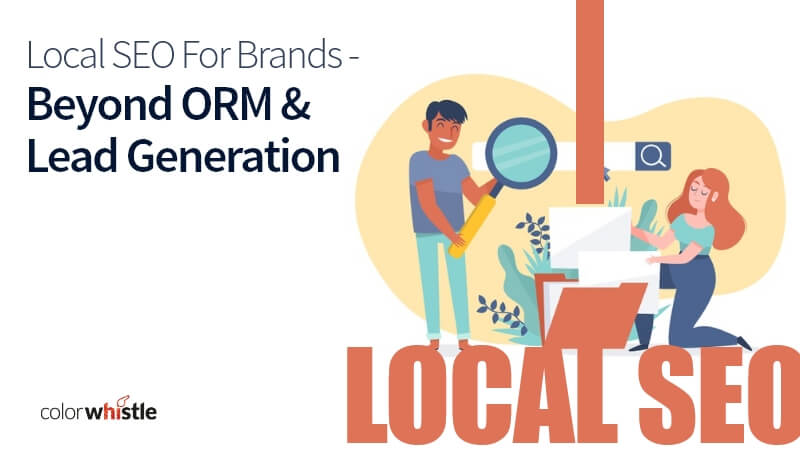

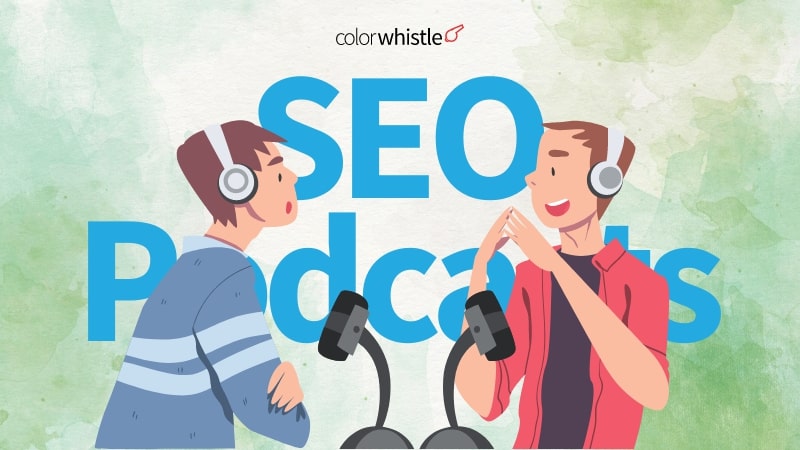
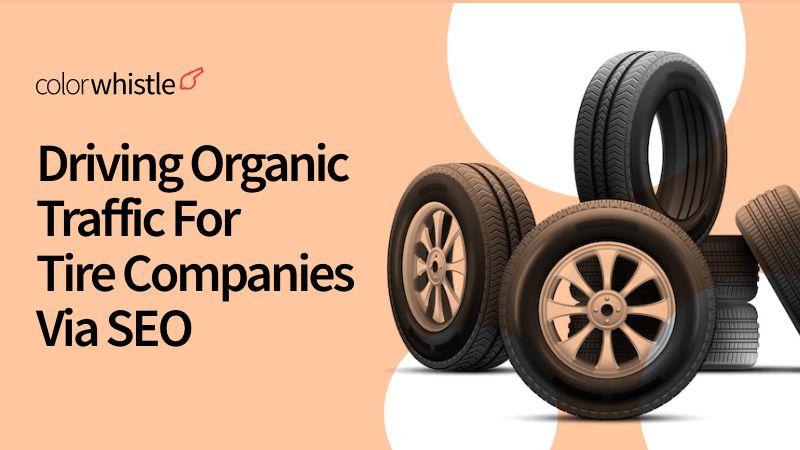

Hey,
Thanks for the blog learned something new today about SEO. Much appreciated.
Thank you for sharing this blog post. This is very informative post.